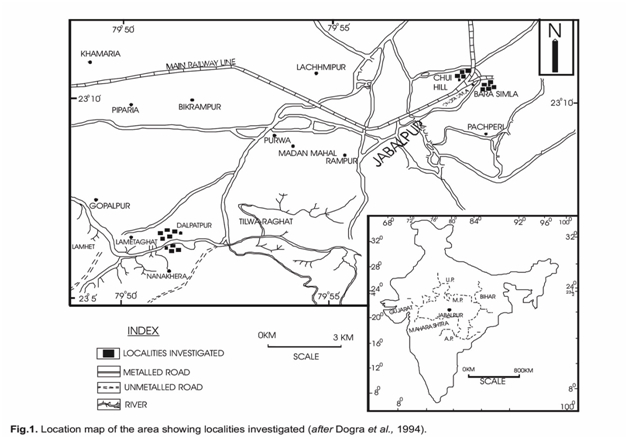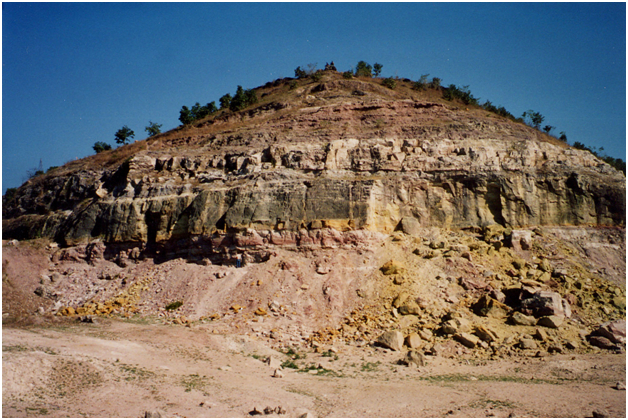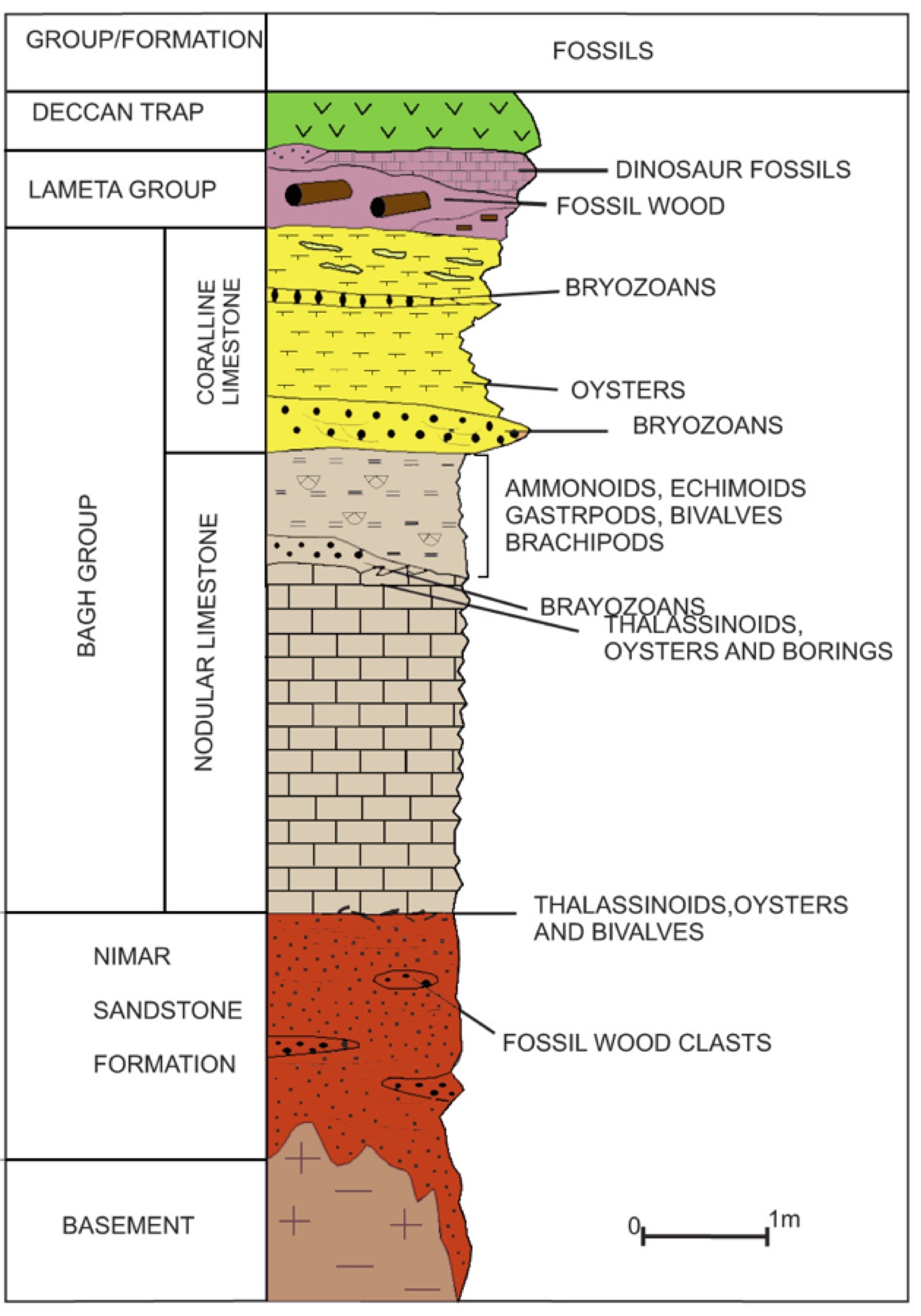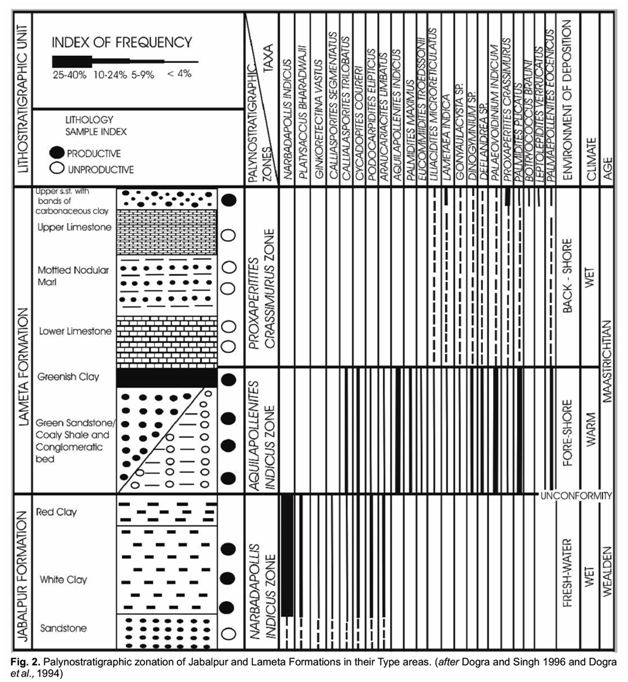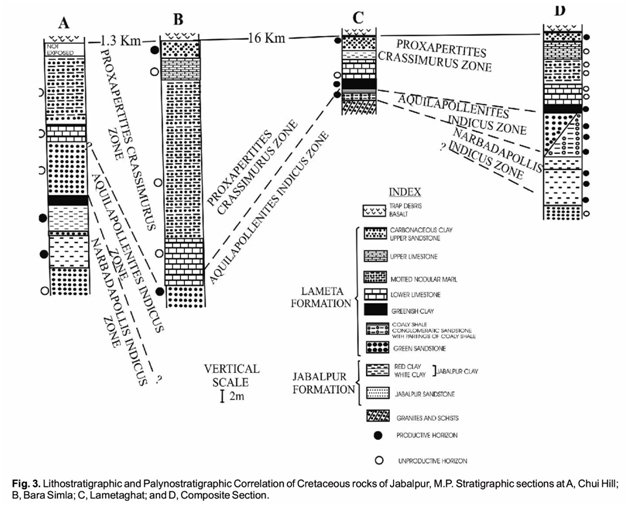Jabalpur Fm
Type Locality and Naming
Satpura Basin: Upper Narmada valley near Jabalpur. Oldham (1871) named the youngest Gondwana sequence in the Satpura area of central India after the town Jabalpur in a quarry cutting (Chui Hill) near the railway station as the Jabalpur Formation. It was earlier referred to as Upper Damuda by Medlicott (1860). [Original Publication: Oldham, T. 1871. Sketch of the Geology of the Central Province. Rec. Geol. Surv. India 4(3), 69-82.]
[Figure 1: Location map of Jabalpur showing the position of Lameta Ghat, Chui Hill, and Bara Simla sections where the Jabalpur and Lameta formations are expose (Dogra et al., 2010)]
Lithology and Thickness
Sandstone. In Satpura Basin, it consists of soft, yellow, brown or white, irregularly or falsely bedded massive sandstone. A conglomeratic horizon is generally present at the contact of the Precambrian basement and the basal sandstone of the Jabalpur Formation. The sandstones are followed by fine clays and soft argillaceous and sandy shales with subordinate intercalations of white sandstones. The white color of the upper part of the sequence which sometimes changes into purple or red contrasts it from the lower part of the section in the field (Dogra et al., 2010). The thickness of the Jabalpur Formation varies between 45 and 185 m in the Narsinghpur district of Madhya Pradesh. In the Chui Hill, the exposed part of the section measures about 16 m (Dogra et al., 2010).
In Narmada Basin, the Jabalpur Formation rests unconformably over Precambrian metamorphic rocks with a well-developed conglomeratic bed, comprises of yellowish-brown or white sandstones devoid of any pebbles in the lower part. The sandstones pass upwards into soft argillaceous and sandy shales, fire clays with subordinate intercalations of white sandstone (Dogra et al. 2010). Medlicott (1873) reported a coal seam at a depth of about 11 m. Outcrop thickness in Chui Hill is 16m, known range from 45 to 185 m in Narsinghpur district in Madhya Pradesh (Crookshank, 1936).
[Figure 1b: Composite stratigraphic column of the Bagh Group (after Tripathi, 2006)]
[Figure 2: Chui Hill section, Jabalpur showing clays of Jabalpur formation at the base and Lameta lithounits above.]
Relationships and Distribution
Lower contact
The Jabalpur Formation rests nonconformably over the Precambrian rocks of the Mahadeva Group (Mahadeva Gr) with a conglomeratic bed in the type area, or on the Denwa Fm and Bagra Fm with a pronounced unconformity in the Satpura Basin; or onto Parsora Fm in South Rewa (Son) Basin.
Upper contact
The Jabalpur Formation's topmost pinkish clay/sandstone horizon is overlain by the Green Sandstone of the Lameta Fm with a paraconfirmity (Dogra et al., 2010), or by the Deccan Traps Fm.
Regional extent
Upper Narmada valley near Jabalpur. In Satpura Basin: The formation is developed from South Rewa coalfields along the southern side of the Narmada Valley and is seen capping the northern hills of Satpura Range. A smaller exposure is also found on higher ground to the north and south of Morand River, west of the Satpura outlier.
GeoJSON
Fossils
Only plant fossils have been reported from the Jabalpur Formation. The flora from this formation is represented by typical Upper Gondwana elements, with Coniopteris, Cladophlebis, Nilssonia and Ptilophyllum as the common plant taxa documented from this formation (Pascoe, 1960).. Megaflora: Ptilophyllum, Pterophyllum, Dictyozamites, Anomozamites, Ctenis, Taeniopteris, Pachypteris, Ginkgo, Araucaria, Pagiophyllum. Brachyphyllum,Elatocladus, Moranocladus, Araucarites, Weichselia, Onychiopsis, Phlebopteris, Hausmania, Cycadopteris, Gleichenia and Allocladus (Feistmantel, 1877c; Crookshank, 1936; Bose and Sukh Dev, 1958, 1971; Bose, 1959a; Shah et al. 1973; Sukh Dev and Bose, 1974; Bose and Banerji, 1981; Sukha Dev and Zeba-Bano, 1977, 1980, 1981; Bose and Zeba-Bano, 1978; Zeba-Bano, 1979); Palynoflora: Cyathidites, Callispora, Bossisporites, Lametatriletes, Haradisporites, Dictyophyllidites, Todisporites, Klukisporites, Cicatricosisporites, Contignisporites, Aequitrivadites, Cooksonites, Crybelosporites, Coptospora, Triporoletes, Calialasporites, Araucariacites, Podocarpidites, Podosporites, Cycadopites, Monoletes, Classopollis (Kumar (1994); dinocyst: Kalyplea, Sentusidinum and Canningea (Jain et al., 1982). Dogra et al. (1988, 1994, 2010) documented palynotaxa comprising Aequitriradites spinosus, Neoraistrickia pallida, Contignisporites dettmanii, Crybelosporites sp. cf. C. stylosus, Cicatricosisporites australis, Schizosporis minutus, Tricolpites psilatus, Coptospora mesozoica which straddle the Tithonian – Neocomian time interval and placed it within the palynozone Narbadapollis indicus Zone.
[Figure 3: Palynostratigraphic zonation of Jabalpur and Lameta formations in the type area as proposed by Dogra & Singh, 1996; and Dogra et al., 1994)]
[Figure 4: Lithostratigraphic and palynostratigraphic correlation of Cretaceous rocks of Jabalpur. A. Chui Hill, B. Bara Simla Hill, C. Lametaghat, D. Composite section (adapted from Dogra et al., 2010)]
Age
Depositional setting
Sediments of the Jabalpur Formation were deposited as fluvial and fluvial-lacustrine sediments over a large extent in the eastern part of Satpura basin having southerly dispersal pattern. The clays and carbonaceous shales were deposited in flood plains and isolated shallow lakes fed by this system. Continued subsidence resulted in the deposition of the upper part of the Jabalpur Formation over a wide area in a fluvial regime overlapping most of the earlier deposited Gondwana sediments (Peters and Singh, 2001). Based on the absence of coastal vegetation or phytoplankton in the palynological assemblage, a freshwater depositional environment was inferred by Dogra et al. (1994).
Additional Information
References
Bose and Banerji, 1981; Bose and Sukh Dev 1971 Bose and Sukh Dev, 1958 Bose and Zeba-Bano, 1978; Bose, 1959a; Crookshank, 1936 Feistmantel, 1877c Gondwana Sedimentation in India. JGSI, 57, 300-320. Jain et al., 1982 Kumar (1994); Oldham, T. 1871. Sketch of the Geology of the Central Province. Rec. Geol. Surv. India 4(3), 69-82. Peters and Singh, 2001. Satpura Basin - An Example of Pre-Rift, Syn-Rift and Post-Rift Peters, 2009 Shah et al. 1973; Sukh Dev and Bose, 1974; Sukha Dev and Zeba-Bano 1980, Sukha Dev and Zeba-Bano 1981; Sukha Dev and Zeba-Bano, 1977, Zeba-Bano, 1979
